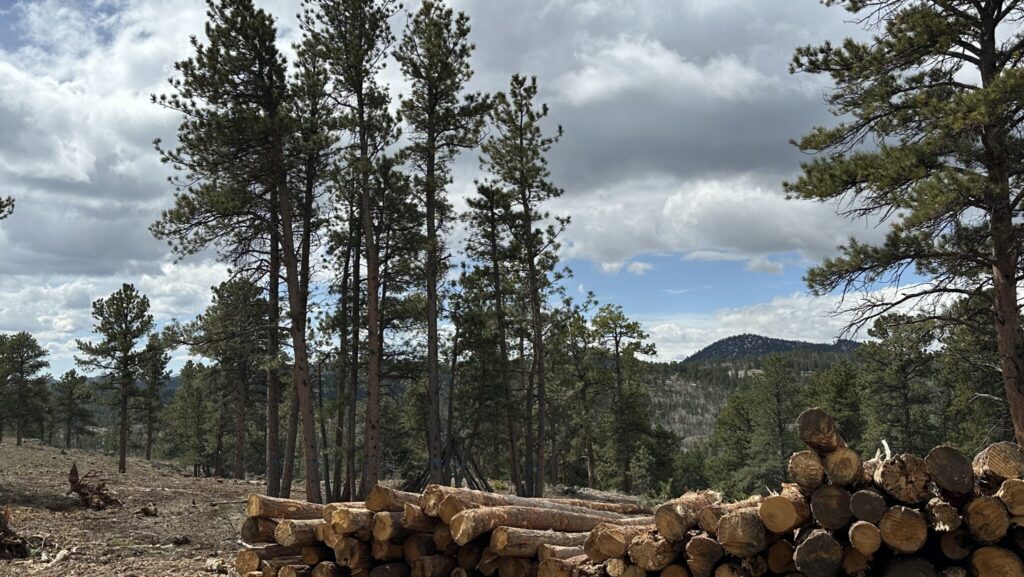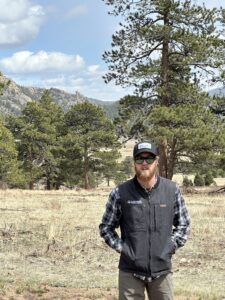Recently we embarked on a classic Colorado spring day adventure, navigating a whirlwind of weather conditions alongside our partners from the Larimer Conservation District (LCD), Larimer County Office of Emergency Management, and over a dozen local community members. Our destination? An active forest health project site nestled in the scenic Cherokee Park area. The aim of our field tour was twofold: to inform those interested in similar endeavors on their land and to highlight the transformation from pre-treatment to post-treatment, providing a real-time glimpse into the restoration process.
Leading our expedition was Dylan Alsbach, Forestry Program Manager for LCD. With his extensive forestry experience nationwide and his passion for forging connections with landowners, Alsbach expertly guided us through the multi-step process of executing a large-scale restoration project on private land. Setting the stage, Alsbach delineated the stark contrast between forest restoration work and mere fuels reduction or timber harvest projects. Unlike the latter, which focus on specific aspects of forest management, restoration endeavors strive to rejuvenate landscapes to their natural fire-adaptive state, fostering biodiversity and resilience. Restored forests are more biologically diverse with trees varying in structure and composition, a rich understory of plants and a variety of wildlife. “How we accomplish this varies by site and if we’re doing our jobs right, no one acre is going to look like another” said Alsbach.
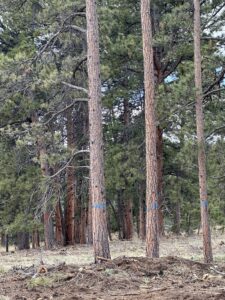 The meticulous nature of forest restoration became evident as Alsbach detailed his team’s approach. Every site is thoroughly surveyed, with each tree earmarked for preservation. These sentinel trees, often centuries old, bear witness to bygone fires, offering invaluable insights into the ecosystem’s historical dynamics. Furthermore, natural features such as rocky outcrops and water bodies serve as firebreaks, warranting special consideration during the planning phase. Crucially, Alsbach stressed the importance of community education, emphasizing that the process may diverge from conventional expectations, with community engagement trumping tree-cutting in significance. “Educating landowners so they understand the science is a huge piece of our work. It looks different than people might expect,” explained Alsbach. He emphasized that community engagement is often a larger component of the work than cutting the trees.
The meticulous nature of forest restoration became evident as Alsbach detailed his team’s approach. Every site is thoroughly surveyed, with each tree earmarked for preservation. These sentinel trees, often centuries old, bear witness to bygone fires, offering invaluable insights into the ecosystem’s historical dynamics. Furthermore, natural features such as rocky outcrops and water bodies serve as firebreaks, warranting special consideration during the planning phase. Crucially, Alsbach stressed the importance of community education, emphasizing that the process may diverge from conventional expectations, with community engagement trumping tree-cutting in significance. “Educating landowners so they understand the science is a huge piece of our work. It looks different than people might expect,” explained Alsbach. He emphasized that community engagement is often a larger component of the work than cutting the trees.
Witnessing Transformation: From Landing Sites to Lush Landscapes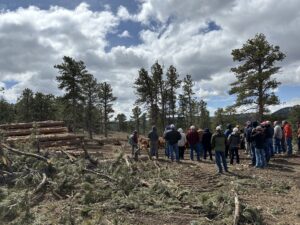
Our first stop on the Cherokee Park tour led us to a “landing site,” where felled trees are processed before repurposing. Here Alsbach provided a candid glimpse into the initial phase’s intensity and temporality. The landing site is by far the most impacted area of a project due to the concentration of heavy equipment coming and going from the site. The reason for beginning the tour at this location was to provide full transparency to the curious landowners of what they are going to experience initially. “It’s intense, it’s emotional and it’s temporary” explained Alsbach. While the site may seem profoundly disturbed initially, nature’s resilience swiftly asserts itself, with lush grasses and wildflowers adorning the landscape within a year post-treatment. Recognizing the vulnerability of exposed terrain, LCD collaborates with the Larimer County Weed District to implement effective noxious weed control measures, safeguarding the site’s ecological integrity.
Venturing further, we encountered the rugged terrain characteristic of many landowners’ properties, underscoring the complexities of mechanized work on steep slopes. Through careful planning and employing highly skilled contractors, LCD ensures safety and efficacy in even the most challenging terrains.
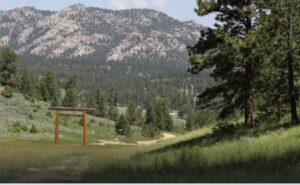
The day culminated in a visit to a fully restored project site, displaying a vibrant, fire-ready forest ecosystem at the beautiful Drala Mountain Center. Notably, the comprehensive restoration efforts by LCD here played a pivotal role in containing a branch of the 2020 Cameron Peak Fire, underscoring the tangible impact of such endeavors on community safety and ecosystem resilience.
Collaborative Solutions: Funding and Partnerships
Forest restoration is a labor-intensive endeavor, spanning years from inception to fruition. From outreach and education to planning and execution, every phase demands unwavering commitment and resources. With costs exceeding $6,000 per acre for projects involving complete biomass removal, securing funding from diverse partners is imperative. It is through collaborative efforts, bolstered by organizations like Peaks to People Water Fund, that initiatives like those in Cherokee Park become feasible.
Join us in supporting the crucial work of forest restoration in Northern Colorado! Visit our website’s Projects page to learn more about initiatives like the one in Cherokee Park and discover how you can contribute. Your support allows us to collaborate with partners and amplify the impact of our collective efforts. Together, we can accelerate the pace and scale of forest restoration, safeguarding the health and resilience of our cherished landscapes for generations to come.
